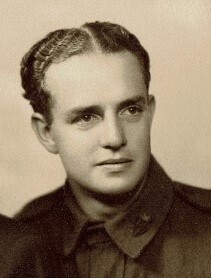PIGGOTT, Walter Robert
| Service Number: | SX33659 |
|---|---|
| Enlisted: | 12 June 1944 |
| Last Rank: | Corporal |
| Last Unit: | Not yet discovered |
| Born: | Booleroo Centre, South Australia, 26 February 1920 |
| Home Town: | Parkside, Unley, South Australia |
| Schooling: | Willowie Primary School, South Australia |
| Occupation: | Farmer |
| Died: | Natural Causes, Booleroo Centre, South Australia, 27 May 2001, aged 81 years |
| Cemetery: |
Booleroo Centre Cemetery |
| Memorials: | Orroroo Morchard Men Roll of Honor, Willowie WW2 Roll of Honour |
World War 2 Service
| 12 Jun 1944: | Involvement Corporal, SX33659 | |
|---|---|---|
| 12 Jun 1944: | Enlisted Wayville, SA | |
| 12 Jun 1944: | Enlisted Australian Military Forces (WW2) , Corporal, SX33659 | |
| 2 May 1945: | Embarked Australian Military Forces (WW2) , Corporal, SX33659, Transferred to Morotai as Tech maintenance until end of war | |
| 20 Aug 1946: | Discharged | |
| 20 Aug 1946: | Discharged Australian Military Forces (WW2) , Corporal, SX33659 |
Help us honour Walter Robert Piggott's service by contributing information, stories, and images so that they can be preserved for future generations.
Add my storyBiography contributed by Di Barrie
Walter (Wally) Robert Piggott was born at Booleroo Centre 26 February 1920, the first and eldest child of Albert Edwin and Gladys May (nee Bonnett) Piggott. Albert and Gladys farmed ‘Sandy Grove’ - section 66, Hundred of Willowie.
Wally was single when he first registered for military service at Peterborough 5 March 1941, listing his occupation as labourer. However he was also an accomplished lathe operator, making replacement parts for broken machinery for himself and other local farmers. He was not called up for full time service until 1944. Prior to this he had been working at the Islington Railway Workshops. During WW2 the workshops were involved in the construction of a number of armoured vehicles, most notably armoured cars and Bren Gun carriers. It was here he met his future wife, Sheila Joan Chirgwin.
Wally married Sheila at North Adelaide on the 9 June 1944, just three days before he reported for full time duty at the South Australian Lines of Communication Recruit Reception Depot, Wayville. A few days later he was transferred to the Australian Recruit Training Centre at Cowra, NSW, where he joined 1 Aust Recruit Training Battalion (Btn). On the 5 August 1944 Japanese POW’s housed in the detention camp at Cowra staged a breakout, storming the perimeter fences. The unsuccessful attempt at freedom resulted in 231 Japanese deaths, with a further 108 wounded. All survivors were recaptured in the surrounding countryside in the following days.
In September 1944 he left Cowra for the Aust Central Signals Training Depot at Bonegilla (Victoria), where he joined 1 Aust Signals Training Btn, and then on to 3 Aust Motor Transport Training Depot (also at Bonegilla) to attend Course No 97 as a Driver/Mechanic. January 1945 he had another move. He was sent to the 3 Aust Army Trades Training Depot at Camp Pell (Royal Park - Melbourne) for further driver/mechanic training.
Now fully trained he moved to Queensland to the 5 Aust Advanced Reinforcement Depot at Wacol, via 1 Aust Personnel Staging Camp at Yeerongpilly before being assigned to 1 Aust Advanced Reinforcement Depot at Warwick prior to service overseas.
Wally departed Brisbane 2 May 1945 aboard HMAS ‘Kanimbla’ for Morotai, a small island that at the time was part of the Netherlands East Indies. This base played an important role in the liberation of the Phillipines and to support the Australian led Borneo campaign. After a short period at 1 Base Sub Area Details Depot he was posted to 4 Technical Maintenance Section which operated a workshop and maintained equipment for Advanced Land HQ Signals, where he was graded as Trade Group 1 Fitter Signals (and got a long awaited pay rise) plus a promotion to Corporal on 31 January 1946. Prior to this he had been classified as a Signalman, not a Private.
Being a late arrival he did not have a high priority for discharge after cessation of hostilities, so he stayed at Morotai for some time. In February 1946 he transferred to 94 Wireless Section (Heavy), before returning to Australia 15 July 1946. He was formally discharged from the army on the 20 August 1946 at Hampstead, South Australia, having served 361 days in Australia and 440 days on overseas service.
After his discharge Wally returned to Willowie, farming Sections 65s, 66, 68 and 171, Hundred of Willowie. He and Sheila had two children. In his retirement Walter gained a lot of satisfaction making models of motors, pumps and machine tools. Wally died 27 May 2001, aged 81 years. He is interred at Booleroo Cemetery, South Australia, Plot 819.
Excerpt taken from book "Diggers From the Dust" (2018) Di Barrie and Andrew Barrie










